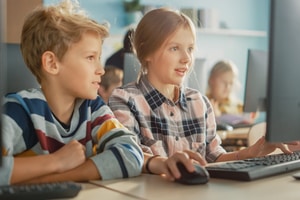5 Fun Alternatives To Classroom Learning
Classroom learning refers to the traditional way of teaching within the physical confines of a classroom within a structured learning environment. This setup requires students and teachers to be physically present in the school during in-classroom education.
It’s about the teacher taking center stage and doing all the talking while the students are glued to their chairs, listening. The focus is solely on giving pieces of information without regard to teacher-student engagement.
Alternative Activities for Learning
Student-centered learning refers to a vast variety of educational programs, learning experiences, instructional methods, and academic-support activities that help meet the unique learning needs, interests, aspirations, or cultural backgrounds of individuals and groups of students.
Because of this, there have been several fun alternatives to classroom learning that schools and educators use today to help improve students’ learning engagement and performance.
To date, there are multiple options of alternative activities for learning; it’s no longer just confined to a four-cornered room. Some are doable whether a child is enrolled in a traditional, online, or homeschool setup.
1. Learning Through Play
A term used in psychology and education to describe how kids might learn to understand their environment is learning through play. The act of playing can help a child grow emotionally, improve their social and cognitive skills, and increase their self-confidence as they explore new situations.
Children learn through play. The skills they learn include problem-solving, strategic thinking, relating to others, and managing life’s ups and downs.
2. Learning Through Field Trips
Field trips help strengthen a child’s education. It’s an activity where a student or group goes out of the classroom and visits a specific place to learn and explore. Field visits are frequently seen as an essential aspect of the educational process in a school setting. Students often remember them as some of their favorite and most memorable school days.
While field trips can enhance a history lesson about the Civil Rights movement or a textbook chapter on marine life, they also have other educational benefits. They provide teachers and students with an opportunity to interact outside of the classroom. The sharing of experiences strengthens the relationship between teachers and students, as well as the friendships between classmates.
When kids have a shared connection with their classmates, they are more comfortable sharing knowledge and assisting each other in their learning as the school year progresses. In addition, they can develop long-lasting friendships throughout their academic careers.
3. Learning Through Road Schooling
Road schooling may be a unique form of homeschooling, but this can also be a great alternative experience for students enrolled in a traditional school. It is similar to field trips because road schooling combines travel and education.
Going on road trips is a fun and exciting way to explore different regions throughout the country and around the world. Making road schooling easy will be a breeze if you plan it as a family. It’s flexible, as you can plan trips based on your needs and interests. Thus, you’ll have the opportunity to strengthen family ties and make priceless memories.

4. Learning Through Scavenger Hunt
A scavenger hunt is an activity where the hosts create a list of specified items that the participants must collect or accomplish, usually without spending any money. Scavenger hunts are generally participated in by people in small groups, but you can always modify them to make it an individual hunt.
Scavenger hunts offer kids a practical platform for problem-solving and computational thinking. Students can apply techniques they learned from their parents or teachers, resulting in a more successful learning experience. It is easy to adapt a scavenger hunt to the interests and abilities of your child.
5. Learning Through Role-Playing
Role-playing allows students to directly apply the material by placing them in the position of a decision maker. Using this method keeps students engaged and allows them to communicate with one another while working on the task set for them. Students may work in groups on this activity or act out their roles for the entire class period.
Through this process, students become more engaged with the content as they attempt to respond to it from their character’s perspective. Moreover, it inspires students and improves existing teaching methods by providing real-world examples. As a result, they can develop and use practical skills (negotiation, debate, teamwork, cooperation, persuasion).
Final Thoughts
Alternative activities may be a preferred method for most educators and parents, the foundation upon which we all stand is the traditional classroom. It’s important to note, as contemporary educators, to add and incorporate new, successful teaching methods to adapt to the changing times. Changing little things here and there is never a bad thing if it means students will learn better and love learning more.




 Katie Brenneman is a passionate writer specializing in education, mental health, family lifestyle and online safety. When she isn’t writing, you can find her with her nose buried in a book or hiking with her dog, Charlie. You can follow her on
Katie Brenneman is a passionate writer specializing in education, mental health, family lifestyle and online safety. When she isn’t writing, you can find her with her nose buried in a book or hiking with her dog, Charlie. You can follow her on 
 Ava Roman (she/her) is the Managing Editor of
Ava Roman (she/her) is the Managing Editor of



